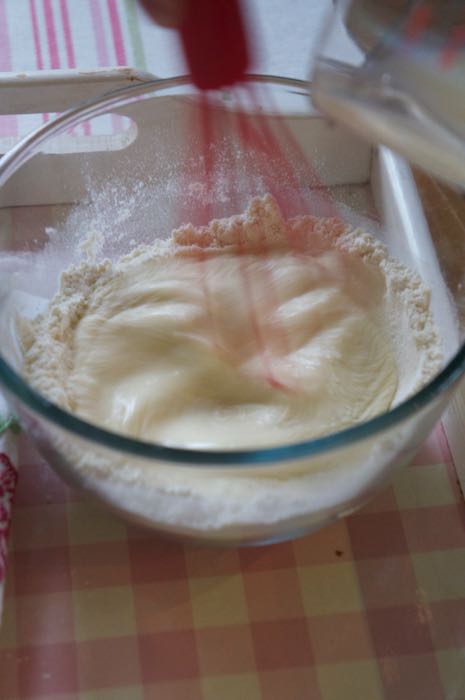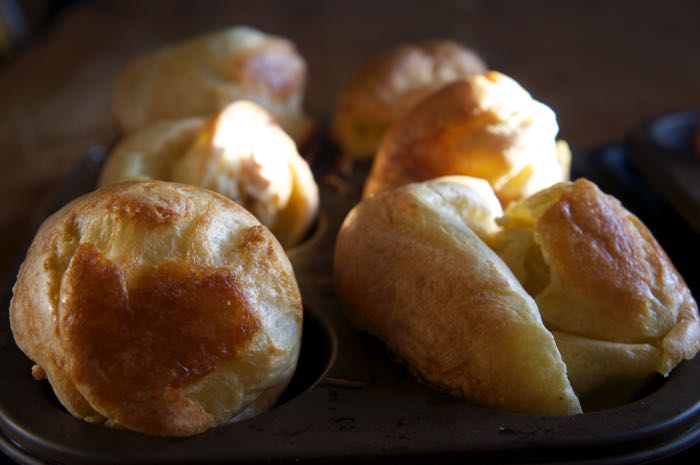I pride myself on being able to make most things in the kitchen reasonably well. I’ve got pavlovas licked, I make a mean curry, my cheesecakes are up with the best of them and soufflés don’t daunt me or bring me out in a nervous sweat. Pastry – got it wrapped, Genoise sponge – piece of cake, Yorkshire puddings ……
Hold on, did I just mention that humble pudding, made of a simple baked batter mixture, so easy that a ten year old should be able to whisk up a decent offering to accompany the Sunday roast.
Yes folks, I have my nemesis. My Yorkshire pudding failure has haunted me for years, I actually gave up at one point and hoped nobody would notice that our Roast Beef seemed sadly lacking in something and toad-in-the-hole was off the menu – for good.
As the daughter of a Yorkshireman this is somewhat of an embarrassment. My father was one of fourteen children in a very poor household in the northern town of Sheffield. I remember his much loved mother, Lily, as a small, feisty, white-haired lady, always bustling about with an apron tied around her ample waist. I didn’t see her much in the course of growing up as my father moved to London as a teenager where he met my mother and settled down to raise his family. But before Lily, my Grandmother, died, my father made sure that we went up to stay with her as often as we could and at the very least every Easter holiday.
 My father still tells me stories of stealing her hot bread cakes off the kitchen windowsill, usually followed by a clip round the ear, if he was lucky by a hand, if not a rolling pin. He often reminisces about her gigantic pots of kale soup and the one thing I can remember really clearly (apart from the Izal toilet paper in the outside privy and the incredibly high beds), her Yorkshire Pudding.
My father still tells me stories of stealing her hot bread cakes off the kitchen windowsill, usually followed by a clip round the ear, if he was lucky by a hand, if not a rolling pin. He often reminisces about her gigantic pots of kale soup and the one thing I can remember really clearly (apart from the Izal toilet paper in the outside privy and the incredibly high beds), her Yorkshire Pudding.
As was traditional and typical at the time, Yorkshire pudding was served in my Grandmother’s house as a starter with gravy, a cheap filler to make hungry children feel full before eating their more expensive main course.
 She used to make a big slab, no fiddly little individual ones reserved for us soft Southeners. A pan full that would feed a hoard, quite flat in the middle but puffy and crispy on the outside. Her ‘seasoned pudding’ with additional onions and herbs tasted divine, we were quite happy eating seconds of pudding while waiting for the roast, which was always a large hunk of beef with plenty of fat. Cooked to perfection in her old range, not a modern gadget or cookery book in sight but a Sunday roast fit for a king.
She used to make a big slab, no fiddly little individual ones reserved for us soft Southeners. A pan full that would feed a hoard, quite flat in the middle but puffy and crispy on the outside. Her ‘seasoned pudding’ with additional onions and herbs tasted divine, we were quite happy eating seconds of pudding while waiting for the roast, which was always a large hunk of beef with plenty of fat. Cooked to perfection in her old range, not a modern gadget or cookery book in sight but a Sunday roast fit for a king.
Despite attempts at various recipes and usually reverting back to the simple Mrs Beeton formula, my attempts, and I am talking 30 years worth of attempts here, have been largely hit and miss affairs. Mainly miss and a long way off target.
 I have followed every tip and piece of advice my mother gave me a long time ago, still the same advice any cook would tell me now.
I have followed every tip and piece of advice my mother gave me a long time ago, still the same advice any cook would tell me now.
I have tried tins of various shapes and sizes. I have tried normal and fan ovens. Different types of fat and always a hot oven and smoking hot oil. The results have been variable to say the last. Nastily flabby, too crispy with no soft bit, stuck like superglue, too eggy or too hard.
Determined not to bring shame upon the Yorkshire side of the family by resorting to Aunt Bessie and not wanting my son to miss out on the delights of toad-in-the-hole which has always been a favourite of children, I decided on one last attempt. Out came Caroline Conran’s Good Home Cooking book which I have featured before as a post.
Using my old but trusty silicone muffin pans, I think I have found the winning combination and to accompany our roast chicken, we shall have Yorkshire puds this week. In fact, I am so confident, that I made two batches, just for experiment’s sake. The recipe states one or two eggs so I have done both. Cooked in different ovens (the same manufacturer) at the same time, same shelf and same temperature, just to see what the difference one little egg makes. They are in the oven as I’m typing this and I can’t tell you how excited I am- I have to keep running into the kitchen and looking through the oven windows. Big thanks to Michael who cleaned the glass for me so I can see what’s going on inside.
I’ve just checked and they are rising beautifully, the two egg ones significantly more. In fact they look too good, my insecure side is telling me that the voluminous puffs will burst and flatten like a piece of bubblegum before they are finished.
Puddings now cooked and as I gaze on my golden puds I feel some sense of honour has been restored to my flagging soul. In future I will use two eggs, the results are significantly larger than the one egg batch but do not taste overly eggy. I am sure that there are mountains of Yorkshire puddings out there better than mine but I am going to phone my father now and tell him I’m not a failure after all.
Ay up, my grandmother would be chuffed.
- 100g plain flour
- 150ml milk and water mixed
- 2 eggs beaten
- pinch of salt
- lard
- Put the flour and salt in a bowl.
- Mix together eggs milk and water.
- Gradually add the liquid to the flour, whisking continuously until the batter is smooth.
- Leave to rest for about an hour.
- Preheat oven to 220c.
- Put a teaspoon of lard or dripping in each hole of a six hole muffin pan.
- Put pan in the oven to heat the oil until it is smoking hot.
- Quickly but carefully distribute the mixture between the holes.
- Cook for 30 minutes until risen and golden brown.




